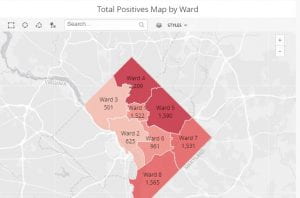 Whether you're staying healthy at home or venturing out for a socially-distanced outing, Healthy Living @ Himmelfarb has some ideas for your summer!
Whether you're staying healthy at home or venturing out for a socially-distanced outing, Healthy Living @ Himmelfarb has some ideas for your summer!
Month: July 2020
ORCIDs: Maintaining Your Online Identity
Have you registered for your ORCID yet? Not sure what ORCID is? Open Researcher and Contributor IDs, or ORCIDs, are a unique digital identifier that distinguishes you from other researchers. ORCIDs are useful to make sure that all of your research is attributed to you personally and that your work can be differentiated from that of other researchers with similar names. Due to current and upcoming mandates from federal funding bodies as well as many journal publishers, the use of ORCIDs is becoming more widespread all the time.
Do you want to learn more about ORCIDs? Himmelfarb Library has a webinar that will help you do just that! In the ORCIDs: Maintaining Your Online Identity webinar, Tom Harrod, Research Support Librarian, explores what an ORCID is and how you can create and curate your own profile. You’ll also learn tips and tricks for easily keeping your ORCID up to date as your research advances.
For more information about ORCIDS, check out the ORCID@GW page of our Scholarly Publishing guide. Be sure to follow us on Twitter for upcoming tips on how to care for your ORCID starting in early August!
Crash Course on Using the Medical Library
 If you’re a first year medical student, you may wonder how a medical and health sciences library differs from other academic libraries. While academic libraries as a whole work tirelessly to support students, faculty and staff during their time at a college or university, medical library professionals seek out services and resources that are specifically targeted towards medical and health professionals.
If you’re a first year medical student, you may wonder how a medical and health sciences library differs from other academic libraries. While academic libraries as a whole work tirelessly to support students, faculty and staff during their time at a college or university, medical library professionals seek out services and resources that are specifically targeted towards medical and health professionals.
It is not necessary for a medical librarian or other library professional to go through medical school or have a prior background in the medical or health sciences career field. Through constant training and professional development, medical library professionals build a foundational knowledge of common medical terms. The staff at Himmelfarb library frequently attend training sessions to broaden our scope of knowledge to better serve our patrons. Some of our staff members are also embedded in various classes and act as an extra source of support within that environment. With this knowledge we are able to tailor our services to the needs of our unique patrons.
Medical research can be a daunting undertaking, but medical libraries provide access to print and electronic book, online databases and academic journals that are instrumental during the research, drafting and publishing process. Himmelfarb’s reference desk is available to answer any questions you may have. Through the use of our Ask A Librarian service, it’s possible to connect with someone in a matter of seconds. If you’re interested in learning more about the various ins-and-outs of scholarly publishing, our Scholarly Communications Committee recently completed a webinar series that touches on various publishing topics. The webinars are located under our Scholarly Publishing libguide. Once you’ve published a peer-reviewed article, we’re able to archive it within our institutional repository--the Health Science Research Commons, also known as the HSRC. With the use of Plumx metrics, it’s easy to track the level of engagement a published article receives. No matter what questions you may have, Himmelfarb is ready to assist.
Medical libraries also strive to provide access to new medical technology. Himmelfarb has several pieces of equipment that can be checked out from the circulation desk. We also house a 3D printer that students, staff and faculty members can use to print various 3D models. This service is by request only. For more information, read the ‘3D Printing at Himmelfarb’ libguide. We’re constantly searching for new and innovative technology that can be used by our patrons and we hope to provide additional technological services in the near future.
Medical librarianship is a dynamic career field that often changes to address the needs of medical and health science professionals. The COVID-19 pandemic has forced library professionals to develop and maintain a virtual learning environment. Though many staff members of Himmelfarb library continue to work remotely, we’re available to answer any questions you may have. We’re thrilled to be an extra source of support during your time at the George Washington University and we look forward to working with you!
How to read a news release
 How to read a news release: Tips from the editors of JAMA
How to read a news release: Tips from the editors of JAMA
Two recent opinion pieces in JAMA address the issue of evaluating and communicating scientific information in the constantly changing era of Covid-19. Journal editors need to maintain standards of scientific integrity as they rapidly process high numbers of time-critical articles. Readers are faced with a deluge of additional information in the form of news releases, pre-prints, and blog posts – most disseminated with little review.
How should a reader approach news releases? Unlike peer reviewed articles, news releases are short and designed to grab attention. They often lack the details to conduct a traditional critical appraisal. Readers therefore might want to ask the following questions to make a quick assessment of the information reported in a news release:
- Does the news release report on a single study?
- Are main outcomes, absolute risks and patient population reported?
- How does the information reported relate to other studies?
- What is the context of the news release? (i.e. from a federal agency or a pharmaceutical company, designed to influence public opinion or report to stockholders)
- Are the opinions of any independent experts included?
- Have study results been reported elsewhere? (i.e. preprint, journals)
To learn more about critically reading a news release, check out the 10 review criteria for news stories listed at HealthNewsReview.org.
Saitz R, Schwitzer G. Communicating Science in the Time of a Pandemic. JAMA. Published online July 13, 2020. doi:10.1001/jama.2020.12535
Bauchner H, Fontanarosa PB, Golub RM. Editorial Evaluation and Peer Review During a Pandemic: How Journals Maintain Standards. JAMA. Published online June 26, 2020. doi:10.1001/jama.2020.11764
HealthNewsReview.org (n.d.) Our Review Criteria. https://www.healthnewsreview.org/about-us/review-criteria
Image: Youngson, N. (no date). Press Release. Retrieved from: https://www.thebluediamondgallery.com/typewriter/p/press-release.html
Copyright for Authors

Do you want to utilize a diagram from a published article in your own publication, but are unsure whether you should do so? Do you have questions about fair use? Himmelfarb Library has developed a short webinar that explores many of the most common questions authors have while writing an article for publication.
In the Copyright for Authors webinar, Anne Linton, Himmelfarb Library Director, and Sara Hoover, Metadata and Scholarly Publishing Librarian discuss tools that can help you determine whether something can be utilized under the fair use doctrine and how to approach items with various creative commons licenses. How to clear rights and respond to publisher questions related to rights are also covered.
Navigating Himmelfarb Library Has Changed!
Covid-19 Publications by GWU Authors
 While Covid-19 has upended many industries around the globe, faculty, staff, and students at The George Washington University have persisted in doing what they do best--researching, learning about, and compiling publications about some of the most pressing healthcare issues of our time. Since the start of the pandemic, researchers and students associated with the George Washington University School of Medicine and Health Sciences, the Milken Institute School of Public Health, and the School of Nursing have published over fifty peer-reviewed articles related to Covid-19. The Himmelfarb Library has compiled a collection of these publications within our institutional repository, Health Sciences Research Commons. The Covid-19 Publications by GWU Authors collection highlights research by students, faculty, and staff and will be updated on a regular basis. Have a publication that needs to be added? Simply email hsrc@gwu.edu with a link to your publication and we will be happy to include your research.
While Covid-19 has upended many industries around the globe, faculty, staff, and students at The George Washington University have persisted in doing what they do best--researching, learning about, and compiling publications about some of the most pressing healthcare issues of our time. Since the start of the pandemic, researchers and students associated with the George Washington University School of Medicine and Health Sciences, the Milken Institute School of Public Health, and the School of Nursing have published over fifty peer-reviewed articles related to Covid-19. The Himmelfarb Library has compiled a collection of these publications within our institutional repository, Health Sciences Research Commons. The Covid-19 Publications by GWU Authors collection highlights research by students, faculty, and staff and will be updated on a regular basis. Have a publication that needs to be added? Simply email hsrc@gwu.edu with a link to your publication and we will be happy to include your research.
Peer Review & Pre-Prints
The emergence of the COVID-19 pandemic has presented numerous, extraordinary challenges which have greatly altered our everyday lives. This public health crisis has led to a demand for information as there is a universal desire for solutions to the problems of protecting ourselves from the virus and curing those who have been infected. As research efforts have accelerated to meet these demands there has been a growing tension as the desire for quick, potentially lifesaving information has led to the spread of inaccurate or misunderstood reports which have been seized upon by large portions of the lay public. This tension within the scientific world between speed and certainty is not new, but the current pandemic has made it more obvious to all.
The world of scientific publishing is notoriously slow and deliberate, as processes like peer-review have long provided a check on the flow of scientific information to ensure quality before the results of research are disseminated to the wider scientific community and ultimately to the public. However during this ongoing crisis, there has been a rise in the publication of pre-prints (i.e., manuscripts which have not undergone formal peer review) as researchers try to get their potentially life-saving information into the hands of clinicians and policy makers as soon as possible. Pre-print services, such as ArXiv in the physics community, have existed for a long time, but they are now receiving more attention than ever.
 In an effort to add a gate-keeper function to the growing world of COVID-19 related pre-prints, MIT Press and the University of California have developed Rapid Reviews: COVID-19, a so-called “overlay journal”, whose function is to sift through the most popular COVID-19 related pre-prints and provide a form of peer-review. This differs from the traditional publishing model as the pre-prints will be selected by editors of the journal as opposed to being directly submitted by the authors themselves. In fact, though authors will be informed that their work has been selected for review by the journal, they will not have a say in whether their pre-print is reviewed or not. Additionally this journal will differ from others in that the identities of the reviewers will be made known, which will hopefully encourage thoughtful and careful reviews.
In an effort to add a gate-keeper function to the growing world of COVID-19 related pre-prints, MIT Press and the University of California have developed Rapid Reviews: COVID-19, a so-called “overlay journal”, whose function is to sift through the most popular COVID-19 related pre-prints and provide a form of peer-review. This differs from the traditional publishing model as the pre-prints will be selected by editors of the journal as opposed to being directly submitted by the authors themselves. In fact, though authors will be informed that their work has been selected for review by the journal, they will not have a say in whether their pre-print is reviewed or not. Additionally this journal will differ from others in that the identities of the reviewers will be made known, which will hopefully encourage thoughtful and careful reviews.
It is hoped that this effort will provide some of the benefits of the traditional peer-review process without significantly slowing the dissemination of important, life-saving information during this time of crisis. It will be interesting to see if efforts like this can lead to more long-lasting changes in the world of scholarly communication when our current time of crisis has passed.
Keeping Up with COVID in the DMV: Sources for Stats
As COVID-19 cases and hospitalizations are on the rise in many US states, here are some trusted sources for tracking the situation in the DMV.
Departments of Public Health:
DC Coronavirus Data - Includes daily numbers tested, positives, and lives lost. Scroll down for the DC Re-Opening Tracker and data by ward, neighborhood, and demographic break outs. Tables include data for cases, quarantine and deaths of public safety personnel. Check the Press Releases area on the home page for a detailed daily summary of Coronavirus Data including trends graphs for transmission and positivity rates, and contact tracing data. 
DC Hospital Status Data - Includes daily ICU, ventilator, and bed capacity, COVID hospitalization counts and total patient counts.
Maryland Coronavirus Disease 2019 Outbreak and Data Dashboard - Cases and testing by county, ICU and Acute bed capacities, percentage positive rates and testing volume 7 day averages since March 2020. Cases and deaths by age, gender, race and ethnicity.
Maryland COVID-19 in Congregate Facility Settings (Nursing Homes) - Staff and resident cases and deaths reported by county and facilities.
Virginia Department of Health COVID-19 Dashboard - Includes total counts and graphic representations of cases, hospitalizations and deaths. Demographics tab provides breakouts by age, sex, race and ethnicity. Interactive localities tab provides options for counts or rates, and bar chart generation by health district and locality. Outbreaks tab shows outbreak data by setting/facility type, including long term care and correctional facilities. MIS-C tab tracks cases of Multisymptom Inflammatory Syndrome in Children by health district.
Virginia Department of Health Data Insights - Includes case and testing data by zip code, COVID-like illness visits to EDs by health regions, and modeling data from the UVA COVID-19 Model.
Other Sources:
COVID-19 Watcher (Cincinnati Children's & University of Cincinnati) - Tool merges county-level COVID-19 data from The New York Times with sources from the U.S. Census Bureau, mapping the data by metropolitan area.
COVID Community Vulnerability Map - Drill down into communities by zipcode or manipulate the map to view populations most vulnerable for severe outcomes if infected with a COVID-like virus and the socioeconomic factors driving that risk.
Virginia Hospital COVID-19 Dashboard - Virginia Hospital & Healthcare Association provides counts of confirmed cases and pui currently hospitalized, ICU beds and ventilators in use, and hospitals with supply shortages.
State Health Workforce Estimator - From the Mullan Institute for Health Workforce Equity at GW, it provides state-level data for considering different strategic approaches to ensure sufficient heath workforce for COVID-19. A Contact Tracing Workforce Estimator is also available.
Washington Post Known Coronavirus Deaths and Cases in DC, Maryland and Virginia - Deaths, cases, daily and cumulative counts for each state, daily deaths per 100,000 residents, deaths by county and city, and hospitalizations by state.
Additional monitoring sites, data dashboards and calculators are available on the COVID-19 Research Guide Epidemiology page. The Health Care Resources page includes capacity calculators and models for hospital utilization. Check the Literature, Database, and Data Resources page for open data sets.
New to Himmelfarb: Reserve Any Study Room!
 For your convenience and safety, Himmelfarb Library has transitioned away from first-come, first-served study room use. All study rooms are now available via advance online reservation! Because of reduced seating capacity in all our study rooms, you can guarantee that you will have a place to study before venturing over to Himmelfarb by reserving a study room.
For your convenience and safety, Himmelfarb Library has transitioned away from first-come, first-served study room use. All study rooms are now available via advance online reservation! Because of reduced seating capacity in all our study rooms, you can guarantee that you will have a place to study before venturing over to Himmelfarb by reserving a study room.
To comply with social distancing requirements, most study rooms only accommodate one user. Several rooms can accommodate 2 people, and one allows for 4 occupants at a time.
Signs near the room entrances remind you of the occupancy limits, and floor decals in the study rooms will indicate where you should sit.
Currently, seating at study tables, computer labs, and individual carrels remain available on a first-come, first-served basis.
Please stop by the Circulation Desk, or call (202) 994-2962, if you have any questions or issues.




